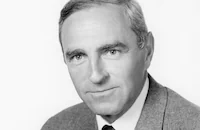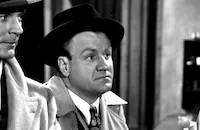Trapped

Brief Synopsis
Cast & Crew
Richard Fleischer
Lloyd Bridges
Barbara Payton
John Hoyt
James Todd
Russ Conway
Film Details
Technical Specs

Synopsis
After a customer hands him a suspicious-looking $20 bill, a bank teller has it checked and it proves to be counterfeit. The bill is then sent to the Secret Service laboratory in Washington, where it is discovered to be a fresh note bearing characteristics of a counterfeiter named Tris Stewart, who is serving a prison term in Atlanta. Two agents, Raymond and Charles, go to see Stewart in prison and suggest that he knows who has the engraving plates used to produce the phony bill, but Stewart offers them no assistance. Several weeks later, while he is being transferred by public bus to Kansas City, handcuffed to a Deputy Marshal, Stewart escapes when a sedan pulls in front of the bus and he grabs the marshal's gun and orders him to unlock the handcuffs. Stewart orders the driver to stop the bus, then flees in the sedan, which is being driven by federal agent Foreman as part of an elaborate ruse to provide a "cover" story for Stewart, who has agreed to help find the counterfeiters in exchange for an early parole. In Kansas City, Foreman asks Stewart about the whereabouts of his former girl friend, Meg Dixon, but Stewart claims not to know where she is. Stewart then attacks Foreman and, after a struggle, knocks him out and heads for Los Angeles. There, he finds Meg using the name Laurie Frederick and working as a cigarette girl at the Chanteclair nightclub. Stewart saves Laurie from the unwanted advances of customer Johnny Hackett and, later at her apartment, tells her that although the "feds" expected him to become a "stool pigeon," he never intended to help them. Unaware that their conversation is being recorded by agents in the basement, he then informs Laurie that they will be leaving for Mexico after he deals with his ex-partner. At the local Secret Service headquarters, meanwhile, Chief Gunby and Foreman receive a visit from Hackett, who is actually John Downey, another agent. The next day, Stewart locates his former partner, Sam Hooker, in a cheap hotel. After Stewart beats him up, Hooker, who was supposed to have saved Stewart's share of the money they made but lost it all gambling and drinking, confesses that he sold the counterfeiting plates to Jack Sylvester, one of their former competitors, who is now running a land investment company. Needing money with which to buy some counterfeit currency, Stewart decides to crack the safe at Laurie's club. The police are waiting, however, and arrest Laurie, but Stewart escapes. Still posing as Hackett, Downey bails out Laurie, then propositions her. Although jealous of his interest in Laurie, Stewart realizes that Downey might be able to finance his deal and, in Downey's hotel room, finds a large sum of cash in a suitcase. Stewart then tells him that, for $25,000, he can buy $250,000 in excellent phony bills. After meeting Sylvester and seeing a sample bill, Downey agrees. However, a subsequent rendezvous proves a failure because Sylvester, who is still unsure about Downey, brings only scraps of blank paper. Later, while dining at the club, Downey's cover is blown in front of Laurie by a young man who recognizes him from the Army. Back at the apartment, after Laurie takes Stewart outside to tell him that Downey is an agent, they both search for a microphone and find it in a lampshade. Deciding that they should still play along, Stewart tells Laurie to buy two tickets to Mexico City for the following evening and instructs her to meet him at the airport. Later, as Downey drives Stewart to meet Sylvester, Stewart draws a gun on him and reveals that he knows he is an agent. Downey is forced to drive to a remote spot overlooking the ocean and told to get out of the car, but manages to overpower Stewart and delivers him to the Venice police station. Downey then phones Gunby and suggests that he go ahead with entrapping Sylvester, as long as Laurie is arrested beforehand. However, the agents cannot find Laurie and when Downey meets Sylvester, he tells him that Stewart has been arrested. They then drive to Sylvester's printing plant, losing agents who are tailing Sylvester's car. Meanwhile, Laurie shows up at Sylvester's office looking for Stewart, which causes Mac Mantz, Sylvester's associate, to become suspicious and take her to the plant. After Downey checks the bills he is buying and Sylvester shows him the plates, Mantz and Laurie arrive, and she tells Sylvester that Downey is an agent. Meanwhile, a motorcycle patrolman calls in the license plate numbers on Sylvester's parked car. Downey tells Sylvester that Stewart is locked up and that he tried to double-cross them both. When more agents arrive, Sylvester shoots Laurie, whom he does not trust, then escapes from the building. After being chased through a trolley car barn, Sylvester is electrocuted atop a trolley car. Later, the federal agents recover the plates and the counterfeit bills, and the Stewart case is closed.

Director

Richard Fleischer
Cast

Lloyd Bridges

Barbara Payton

John Hoyt

James Todd

Russ Conway
Robert Karnes
Bert Conway

Tom Noonan
Ruth Robinson
Rory Mallinson
Mack Williams
Stephen Chase
Harry Antrim
Ken Christy
Renny Mcevoy
Alex Davidoff
Sid Kane
Frank Sully

Lyle Latell
Jack Reynolds

Douglas Spencer
Dick Gordon
Joe Haworth
Lennie Burton
Brick Sullivan
John Damler

Bob Carson
Lucille Barclay
Clancy Cooper
Bruce Hamilton
Charles Regan
Crew
Bert C. Brown
Lee Davis
Alfred De Gaetano
Frank Durlauf
Emmett Emerson
Earl Felton
Bryan Foy
Bryan Foy
Irving Friedman
George Hommel
D'estelle Iszard
Sol Kaplan
Louis Kusley
Armor Marlowe
L. J. Myers
Guy Roe
Roy W. Seawright
Richard Walton
Edith Westmore
Ern Westmore
Wilton Wooten
George Zuckerman

Film Details
Technical Specs

Articles
Trapped (1949)
Producer Bryan Foy was inspired by a real counterfeiting case, the details of which are unknown, and traveled to New York City, Montreal and Washington D.C. to get the necessary clearance for the story and then handed off the idea to writers Earl Felton and George Zuckerman. Foy had developed a reputation as the "Keeper of the Bs." He ran the B unit at Warner Bros. before branching out to start his own independent production company. Felton was an established B-movie screenwriter having sold original story ideas and screenplays to various studios but mostly to Republic. Zuckerman on the other hand was brand new to the game. He was a novelist and short story writer and Trapped was his first foray into writing for a feature film.
At the helm of the picture was director Richard Fleischer who was on loan from RKO. Fleischer was the son of Betty Boop and Popeye animator Max Fleischer, and while raised in a show-business family, he was originally on track to become a psychiatrist. He traded medical school for the Yale School of Drama and was eventually hired to write and direct the RKO-Pathe documentary series This is America in 1943. He went on to have a long career in Hollywood where he dabbled in many genres but found a niche in 1940s and 1950s crime dramas including the celebrated film noir The Narrow Margin (1952).
His background in documentary filmmaking made its way into his feature film work including films such as Bodyguard (1948) and Follow Me Quietly (1949). Trapped was made in conjunction with the Department of the Treasury, with script approval granted to the chief of the Secret Service James J. Maloney, and begins with a documentary style introduction cataloging the functions of the different bureaus and divisions including the Bureau of Printing and Engraving. The film's focus, however, is the Secret Service which was originally tasked to investigate counterfeiting and was part of the Treasury until 2003. Just in case anyone got any funny ideas about taking up counterfeiting, Trapped offered viewers several warnings. A brief interlude beckons the audience's sympathy depicting an innocent woman being informed by a bank teller that her hard-earned money is actually counterfeit. The crime itself is presented as a highly technical skill that requires years of practice and is beyond the reach of your average Joe. Tris Stewart's plates are referred to as "real works of art... like paintings." The final credits offer a thank you the Treasury and a warning about the consequences of committing such a crime.
After a string of supporting roles, Trapped and other Poverty Row films offered Lloyd Bridges an opportunity to prove himself as a leading man. It was also the first substantial role for Barbara Payton who had just gotten her start in Hollywood. The stunning Payton captivated audiences with a mix of both grit and vulnerability. Trapped put Payton on the map and she soon got a contract with Warner Bros. Plagued by personal problems and scandal, her acting career was short lived, ending in 1955 and the troubled Payton died at the tender age of 39 in 1967.
In Bosley Crowther's review of Trapped for The New York Times he said "well-paced as melodrama, this film has momentum, at least. But of course, the conclusion is foregone. Secret Service agents always gets their man." The Variety review says "[Trapped] packs in plenty of suspense and strong melodrama." Many decades later, Trapped enjoyed a revival with contemporary film noir fans. Considered partially lost, for many years a sole 16mm print was known to exist. As with other Eagle-Lion Films, Trapped languished in the public domain with bad copies making the rounds. It wasn't until a private collector donated a pristine 35mm print to the Harvard Film Archive that Trapped was rescued. The film was restored by the Film Noir Foundation and UCLA Film and Television Archive and funded in part by the Hollywood Foreign Press Association's Charitable Trust.
By Raquel Stecher

Trapped (1949)
Quotes
Trivia
Notes
The film's onscreen credits include the following written foreword: "To the Secretary of the Treasury of the United States and his loyal and able assistants of the Secret Service....Our gratitude and thanks for permission to photograph the actual Treasury scenes and for their help and cooperation in the making of this motion picture." A brief survey, done in documentary style, of the varied activities of the U.S. Treasury Department and a detailed account of the production of U.S. currency by the Bureau of Printing and Engraving then is presented. The picture concludes with the following written statement: "The United States currency and the credentials of the Treasury Department shown in this film were photographed by special permission of the Secretary of the Treasury. Further reproduction of said currency or credentials in whole or part is strictly prohibited."
According to an October 1948 Hollywood Reporter news item, producer Bryan Foy traveled to New York, Washington, D.C. and Montreal to obtain clearances for the picture, which was to be based on a "recent counterfeiting case." The same item noted that the film's script had been approved by James J. Maloney, chief of the Secret Service. Although reviews commented on the timeliness of the picture's subject matter, no specific counterfeiting case is cited in contemporary sources. Some scenes in the film were shot on the "streets of Los Angeles," according to the Hollywood Reporter review.















